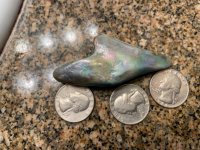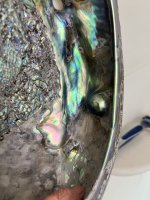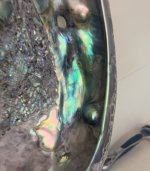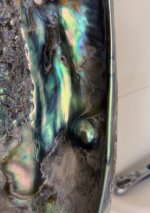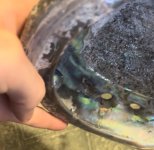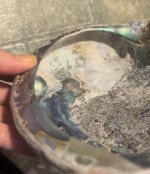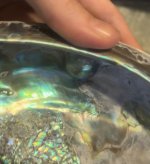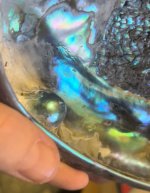Abalone Pearls Defined
Abalone Pearls are natural pearls found in the gastropod mollusk Haliotis. The shells and pearls are most often an iridescent blue color, and the most common shape for pearls are baroque and "horn".

Abalone Shells from Mexico and the United States
Abalone Pearls: Some of the Most Beautiful Pearls in the World
Abalone pearls are considered by many to be some of the most beautiful pearls in the world, and they are also some of the rarest. Abalone pearls come from the gastropod mollusk, Haliotis. The inner mother-of-pearl shell of the abalone has an intense luster and a mixed color palette of blues, lavender, orange, green, pink and silver, in every conceivable combination. The beauty of the abalone pearl is the reflection of this color potpourri in its typical irregular shape.
Abalone Pearls Have a Different Shape
Abalone pearls are very rarely symmetrical. The most common shape is the "horn" shape. This is due to the anatomy of the abalone. A large, brilliant, symmetrical pearl is a 1 in 100,000 occurrence!

A large baroque Abalone pearl from Baja California, Mexico. Photo courtesy of "Baja Pearl Hunter"
Culturing Abalone Pearls Is Difficult
Although abalone pearls are highly desirable and widely sought after, culturing these gems has been an exceedingly difficult venture. Abalone are hemophiliacs, and if they are nucleated in a fashion like a pearl oyster, they will bleed to death quite quickly. Because of this, only abalone Mabe pearls have been successfully harvested on a large scale. The culturing process is distinctly like that of other pearl producing mollusks, except that much more care must be exercised so that the abalone sustains no internal damage.
In 2021, Chilean researchers made it possible to produce bead-nucleated abalone cultured pearls. Read the News HERE.
Abalone Pearls Are Becoming More Plentiful
Abalone pearl jewelry has yet to hit the mainstream in the United States and Europe. The pearl is extremely popular in New Zealand and Australia, in no minor part due to the marketing and farming efforts of the Eyris Blue Pearl Company in New Zealand. As the industry grows, we can expect the beauty of these gems to soon grace the consumers of the West.
Related Articles and Forum Threads:
Abalone Pearls are natural pearls found in the gastropod mollusk Haliotis. The shells and pearls are most often an iridescent blue color, and the most common shape for pearls are baroque and "horn".
Abalone Shells from Mexico and the United States
Abalone Pearls: Some of the Most Beautiful Pearls in the World
Abalone pearls are considered by many to be some of the most beautiful pearls in the world, and they are also some of the rarest. Abalone pearls come from the gastropod mollusk, Haliotis. The inner mother-of-pearl shell of the abalone has an intense luster and a mixed color palette of blues, lavender, orange, green, pink and silver, in every conceivable combination. The beauty of the abalone pearl is the reflection of this color potpourri in its typical irregular shape.
Abalone Pearls Have a Different Shape
Abalone pearls are very rarely symmetrical. The most common shape is the "horn" shape. This is due to the anatomy of the abalone. A large, brilliant, symmetrical pearl is a 1 in 100,000 occurrence!
A large baroque Abalone pearl from Baja California, Mexico. Photo courtesy of "Baja Pearl Hunter"
Culturing Abalone Pearls Is Difficult
Although abalone pearls are highly desirable and widely sought after, culturing these gems has been an exceedingly difficult venture. Abalone are hemophiliacs, and if they are nucleated in a fashion like a pearl oyster, they will bleed to death quite quickly. Because of this, only abalone Mabe pearls have been successfully harvested on a large scale. The culturing process is distinctly like that of other pearl producing mollusks, except that much more care must be exercised so that the abalone sustains no internal damage.
In 2021, Chilean researchers made it possible to produce bead-nucleated abalone cultured pearls. Read the News HERE.
Abalone Pearls Are Becoming More Plentiful
Abalone pearl jewelry has yet to hit the mainstream in the United States and Europe. The pearl is extremely popular in New Zealand and Australia, in no minor part due to the marketing and farming efforts of the Eyris Blue Pearl Company in New Zealand. As the industry grows, we can expect the beauty of these gems to soon grace the consumers of the West.
Related Articles and Forum Threads:
Last edited by a moderator:

